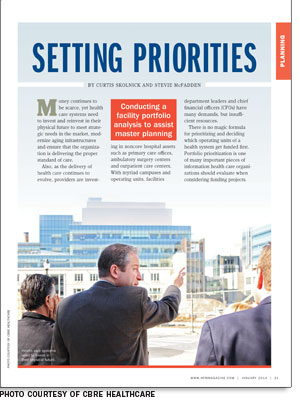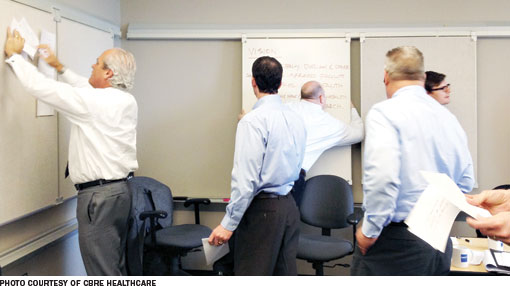
Money continues to be scarce, yet health care systems need to invest and reinvest in their physical future to meet strategic needs in the market, modernize aging infrastructures and ensure that the organization is delivering the proper standard of care.
Also, as the delivery of health care continues to evolve, providers are investing in noncore hospital assets such as primary care offices, ambulatory surgery centers and outpatient care centers. With myriad campuses and operating units, facilities department leaders and chief financial officers (CFOs) have many demands, but insufficient resources.
There is no magic formula for prioritizing and deciding which operating units of a health system get funded first. Portfolio prioritization is one of many important pieces of information health care organizations should evaluate when considering funding projects.
Most systems have some form of operating council, comprising operating unit leaders, in which the executives present business plans and make impassioned cases to system leadership for funding their capital projects.
Strategic master facilities plans should be well-conceived and pass initial muster, but when all of these requests are tallied and laid out by the health system CFO across a multiyear cash map, there still are usually more dollars requested than what the system can spend.
The dichotomy is that these individual master plan projects are necessary for the systems to remain sustainable business and care-delivery entities. Thus, it is easy to see how a system can tie itself in knots trying to make funding decisions when the questions are, "Do we invest in an aging facility in an important core nongrowth market or invest in a facility addition on a campus in a growth market?"
Fortunately, there are tools to analyze and evaluate master plan projects across a health care system, allowing organizations to create a systemwide portfolio of master plan capital projects that prioritizes them based on a set of criteria, understanding the system has a finite set of capital resources.
Developing a plan
The first step to assist leadership is to develop multiyear strategic master facility plans (SMFP) for each operating unit that typically look out five to 10 years, and then prepare a comprehensive portfolio of all the SMFP projects. It is important to break these SMFPs into separable, stand-alone groupings of projects.
Typically, an SMFP is multifaceted and has numerous related projects that can be grouped into "tracks" of investment. These tracks can stand individually and be funded separately.
For example, one track may be the construction of a new patient tower to meet a growth opportunity that also has several interrelated make-ready projects, and another track may be an exterior recladding and replacement of windows on part of an aged building. Both are necessary projects, but can be funded and completed independently. It is important that cash-flow projections be developed on a quarterly basis for each track so the projected spend for all projects can be predicted over time.
The next step is to compile these operating unit projects into a master plan portfolio. It should be an easily digestible summary for operating unit and system leaders, and should be in a spreadsheet matrix format so that data can be sorted, filtered, summarized and utilized easily for graphic representations of a multiyear "spend-ask" cash map.
At minimum, the matrix should capture the following information as data fields:
• The operating unit name (e.g., Memorial Hospital or Main Street Ambulatory Campus);
• A master plan projects track identifier (e.g., MH-1 for Memorial Hospital Track 1);
• A brief master plan project track description that summarizes the major components of the track (e.g., new 60-bed replacement tower, expanded lobby, expanded operating room suite to add four operating rooms and related site improvements);
• The primary nature of the project such as infrastructure (e.g., boiler plant or roof replacement), standard of care (e.g., conversion to all-private rooms) or strategic (e.g., a new digestive disease center to gain a competitive advantage, meet growth projections and provide space for new medical staff recruits);
• The overall estimated total project cost for each track, from planning to occupancy;
• The estimated total project schedule for each track showing start and end dates, from planning to occupancy;
• An overall comparison score.
The portfolio should be reviewed with operating unit leaders to ensure accuracy, and then augmented by providing each final operating unit SMFP and related documentation as an appendix. This will allow operating unit and system leaders to refer to the detail on plans as needed.
Each SMFP should include such typical information as strategic market projections; capacity and space projections; operational, facility and infrastructure assessments; relevant conceptual option drawings; opinions of probable cost; and schedule and phasing plans, among other information.
Scoring and evaluation
To add objectivity to the process of evaluating tracks of projects to fund, not to fund, or defer to a later time, a forced scoring evaluation tool should be developed.
There are many criteria to consider when evaluating SMFP projects. Each criterion should be placed into one of several groups and scored. The score for each rolls up into a weighted criteria group where scores are tallied and then rolled to the total.
By creating these criteria groups, health care organizations can look more deeply into why a project track is important. For example, is it to meet a strategic need, mitigate risk, address an operational issue or some combination?
Suggested criteria, groupings and group weightings include:
Financial (20 percent). This includes capital cost and potential return on investment.
Strategic (25 percent). This includes operating unit growth initiatives, systemwide strategic initiatives, speed-to-market considerations, imminent competitive threats, the need for capacity and potential opportunity costs that could lead to gains for the hospital's competitors.
Risk migration and critical need (30 percent). These include the ability to upgrade standards of care and improve infrastructure.
Operational and physical improvements (25 percent). These include improved access, an image enhancement, flexibility and adaptability, measures to achieve best practices and support new models of care, and improvements to process, flow and throughput.
This list is not exhaustive, but is representative of the main focal points of SMFP projects. Before each project track is scored, there should be agreement from each operating unit leader on the criteria, the criteria groupings and the weighting.
Each criterion is then force-scored on a scale of 0 to 3 related to the main focal points for each SMFP track. One should ask: What are the main reasons and focal points for the projects within this track? Are they to meet a growth initiative need, improve operational flow or improve infrastructure?
Scores would be 0 for "Neutral/Not a Focused Reason," 1 for "Limited Focus," 2 for "Secondary Focus" and 3 for "Primary Focus."
Scores within each criteria grouping are totaled, then multiplied by the grouping weight for a grouping score. The grouping scores are then totaled and rounded to the nearest one-tenth for a final score. All scores should be presented. The scores for each project track then can be compared against one another.
However, it is important that the absolute score not be the only determinant of funding or deferral, but one indicator of overall rationale and need for a project. By creating these criteria groups and presenting the full data, one could look more deeply into why a project track is important.
Individual operating unit scoring matrices should be reviewed with the respective operating unit leader until the leader agrees with the scoring. Other operating unit scoring matrices should be shared only during an operating council with other leaders and system leaders and not until all matrices have been finalized and agreed upon. This way, objectivity will be easier to maintain, and debate and discussion can occur with all information on the table and leaders present.

The last piece
The last piece of the puzzle is to develop a cash-flow map that shows spending requests across a multiyear quarterly timeline. When looking at all SMFPs across a system, the number of project tracks could be in the dozens.
By utilizing the information collected in the portfolio matrix, a graphic stacked-bar chart can be created that shows each quarter as the X axis and potential cash flow as the Y axis. Each quarterly stacked bar represents the total potential quarterly SMFP spend-ask for the system.
The items in the stacked bars can represent color-coded operating unit project tracks (e.g., MH-1 in the previous example could be a light blue item in a quarterly stacked bar). It is important that the system understand its target or available quarterly potential spend related to all of the SMFP projects.
If the total spend-ask is below the quarterly capacity, all is good. In quarters where the spend-ask is more than the total spending capacity, then decisions to fund, defer or change project timing need to be made in order to "smooth" spending so as not to put the system's fiscal health in jeopardy, assuming no shift in spending capacity can be made.
This will cause the leadership operating council of the health system to launch into healthy debate over the merits of one plan and development track versus another.
Informed decisions
Many decisions need to be made to ensure that system resources are appropriately allocated and that the strategic and facilities needs of the operating units are met to ensure viability.
In an effort to help with these decisions, a completed strategic and master facility plan portfolio, scoring matrix and capital request cash map are tools that leaders can utilize to drive adjustments to plans and to make informed decisions. HFM
Curtis Skolnick is managing director and Stevie McFadden is a consultant at CBRE Healthcare in Richmond, Va. They can be reached at Curtis.skolnick@cbre.com and Stevie.mcfadden@cbre.com, respectively.
| Sidebar - Portfolio analysis helps East Coast system to make the right investment decisions |
| An East Coast health care system was seeking a way to make a capital decision based on a flood of master plan and capital requests from its respective hospitals and operating units. To inform decisions, with the assistance of HDR Inc. and CBRE Healthcare, it created a systemwide portfolio of master plan capital projects and developed a tool to prioritize the projects, based on a set of criteria and an understanding that the system has a finite set of capital resources. Creating this portfolio required an inclusive collaborative team effort to ensure that all necessary information was collected and analyzed. The team consisted mainly of the system's design, construction and facility management department; the operating unit leaders of the organization vying for the capital resources; and outside planners, project managers and architects to assist in the organization and consultative efforts. The first steps were to coordinate and develop the portfolio of master plan projects. Some of these projects had been developed over the previous few years by various architects and consultants and some were undergoing final stages of development. The team's charge was not to critique the master plan projects, but to compile and quantify the master plan project information from all system entities in need of the capital resources. These portfolios included, but were not limited to, the summary-level descriptions of the project tracks in the master plan, site drawings, cost opinions and potential project durations. Once all information was received, teams had a better understanding of the needs for each operating unit as well as for the system as a whole. Gaps in information also were identified. One key gap was the lack of coordinated input from the system's strategic planning department. This input was essential to have an all-encompassing vision of any growth initiatives and the system's project priorities. Thus, the planning department began to engage in team discussions. The team then met with all of the operating unit leaders to discuss the methodology for evaluating the capital projects. Evaluation criteria and definitions, scoring methodology, operating unit strategic and growth goals, operating unit strategic master facility plan projects and criteria were reviewed and discussed with each operating unit to gain input on criteria and weights of assessing these projects. From the input received, criteria were adjusted and grouped into broader categories such as financial, critical need, strategic, and operational and physical improvements. Weightings were assigned to each category and the scoring definition was refined to be based on the primary focus of the project. Once all projects were analyzed and evaluated, a visual multiyear quarterly editable cost map, showing a snapshot of all capital projects, was presented as part of the master plan portfolio as if each master plan track were to come to fruition. Thus, overall potential total system quarterly capital spending was computed. The cost map gave an accurate representation of the requests from each operating unit. The information was presented to overall system senior leaders to make informed capital spending decisions. |





